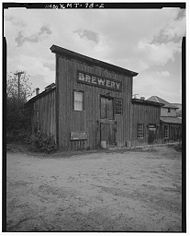Virginia City, Montana
[6] In May 1863, a group of prospectors were headed toward the Yellowstone River and instead came upon a party of the Crow people and were forced to return to Bannack.
A mining district was set up in order to formulate rules about individual gold claims.
The name was intended to honor Varina Howell Davis, the first and only First Lady of the Confederate States of America during the American Civil War.
Upon registration of the name, a Connecticut judge, G. G. Bissell, objected to their choice and recorded it as Virginia City.
[8] Within weeks Virginia City was a boomtown of thousands of prospectors and fortune seekers in the midst of a gold rush.
The remote region of the Idaho Territory was without law enforcement or justice system, with the exception of miners' courts.
[14] Virginia City's population dwindled starting in the 1880s as the easily-extracted placer gold played out and miners moved away.
[16] Charles and Sue Bovey began buying the town, putting much needed maintenance into failing structures.
The Boveys operated the town as an open-air museum complete with artifacts and living history enactments.
Buildings in their original condition with Old West period displays and information plaques stand next to presently active restaurants, gift shops, and other businesses.
[17] The National Park Service (NPS) considered adding the town to its system, conducting studies in 1937, 1980 and 1995.
In the end, the state of Montana bought most of the historic buildings after the legislature authorized the purchase of the Bovey properties.
[17] The commission operates gold panning, the Nevada City Music Hall and Museum, and the Alder Gulch Railroad.
[20] The 2 ft 6 in (762 mm) narrow-gauge Alder Gulch Short Line Railroad transports passengers by rail to the nearby ghost town of Nevada City and back.
The town sits in Alder Gulch, between the Tobacco Root Mountains to the north and the Gravelly Range to the south.



